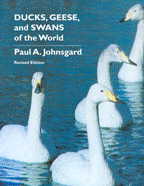Papers in the Biological Sciences
Date of this Version
2010
Abstract
Spotted Whistling Duck
Plumed Whistling Duck
Fulvous Whistling Duck
Wandering Whistling Duck
Lesser Whistling Duck
White-faced Whistling Duck
Cuban Whistling Duck
Magellan Goose
Black-bellied Whistling Duck
White-backed Duck
The whistling ducks are a group of nine species, eight of which are readily placed in the single genus Dendrocygna, or "tree ducks." However, they are not primarily perching birds, and thus "whistling ducks" is a better vernacular designation than the frequently used "tree ducks." In nearly all species both sexes utter a clear, often multisyllabic whistle that readily identifies the bird as to its species and apparently provides important communication signals in these rather gregarious birds. Most of the species are tropical in distribution, and in all of them the pair bond seems to be permanent and potentially lifelong. Both sexes share equally in brood-rearing responsibilities, and in some species the male is known to participate in incubation as well. Unlike those of geese and swans, the downy young are distinctively patterned. Although the downy young of the white-backed duck differ somewhat from those of Dendrocygna, the species shares a sufficiently large number of behavioral and anatomical traits to be tentatively included in this tribe.


Comments
In Ducks, Geese, and Swans of the World, by Paul A. Johnsgard. Electronic edition copyright © 2010 Paul A. Johnsgard.